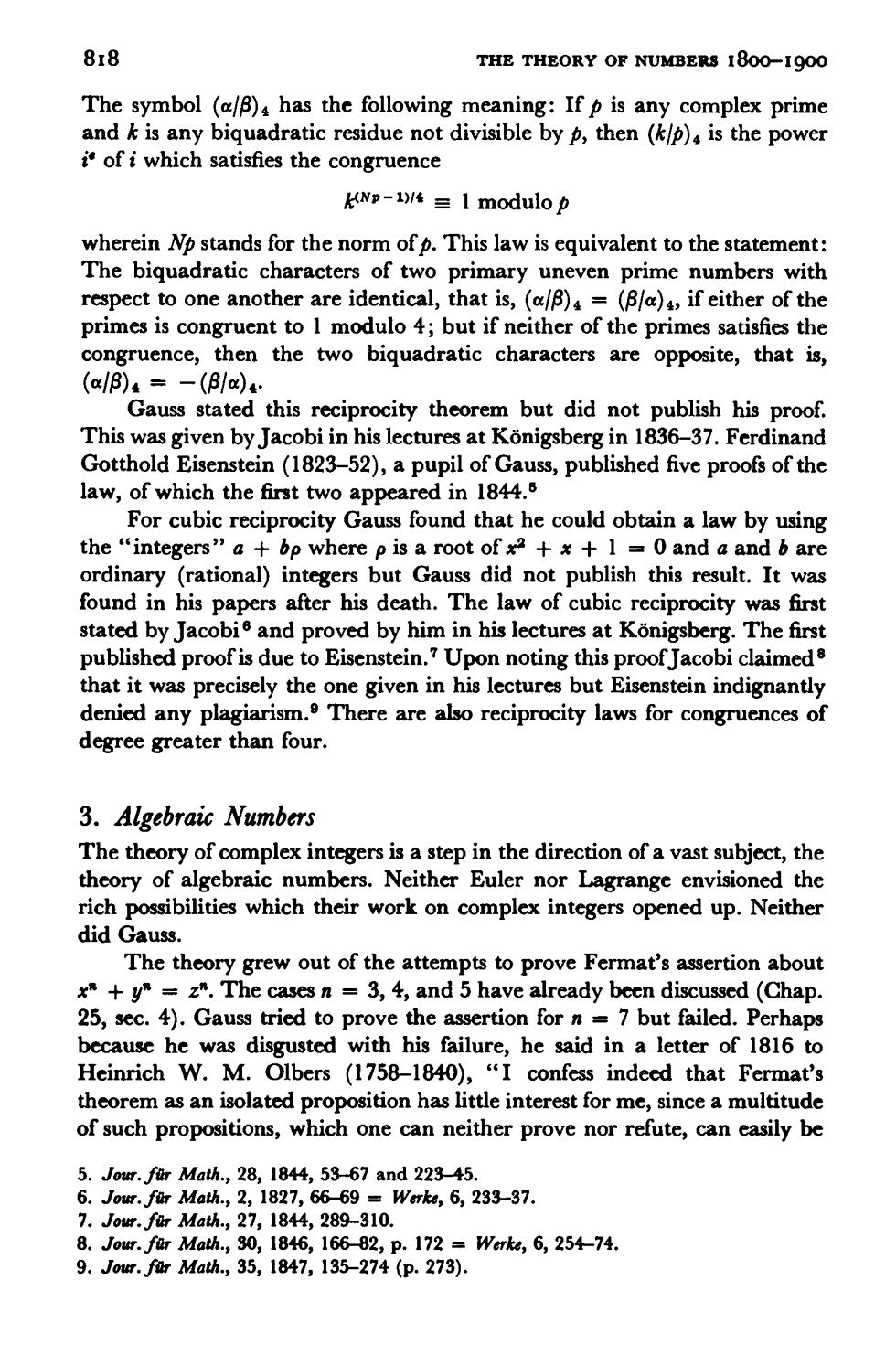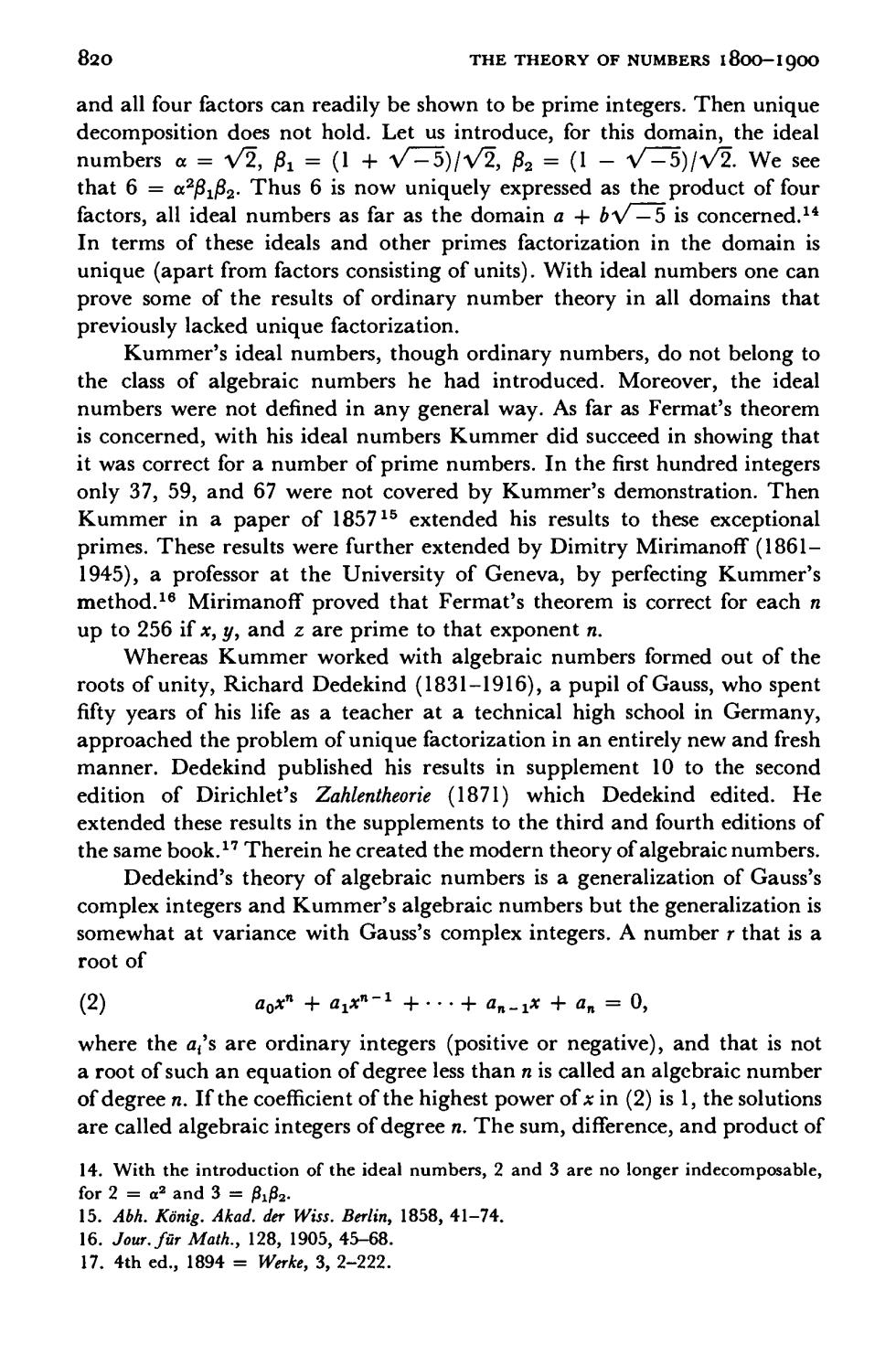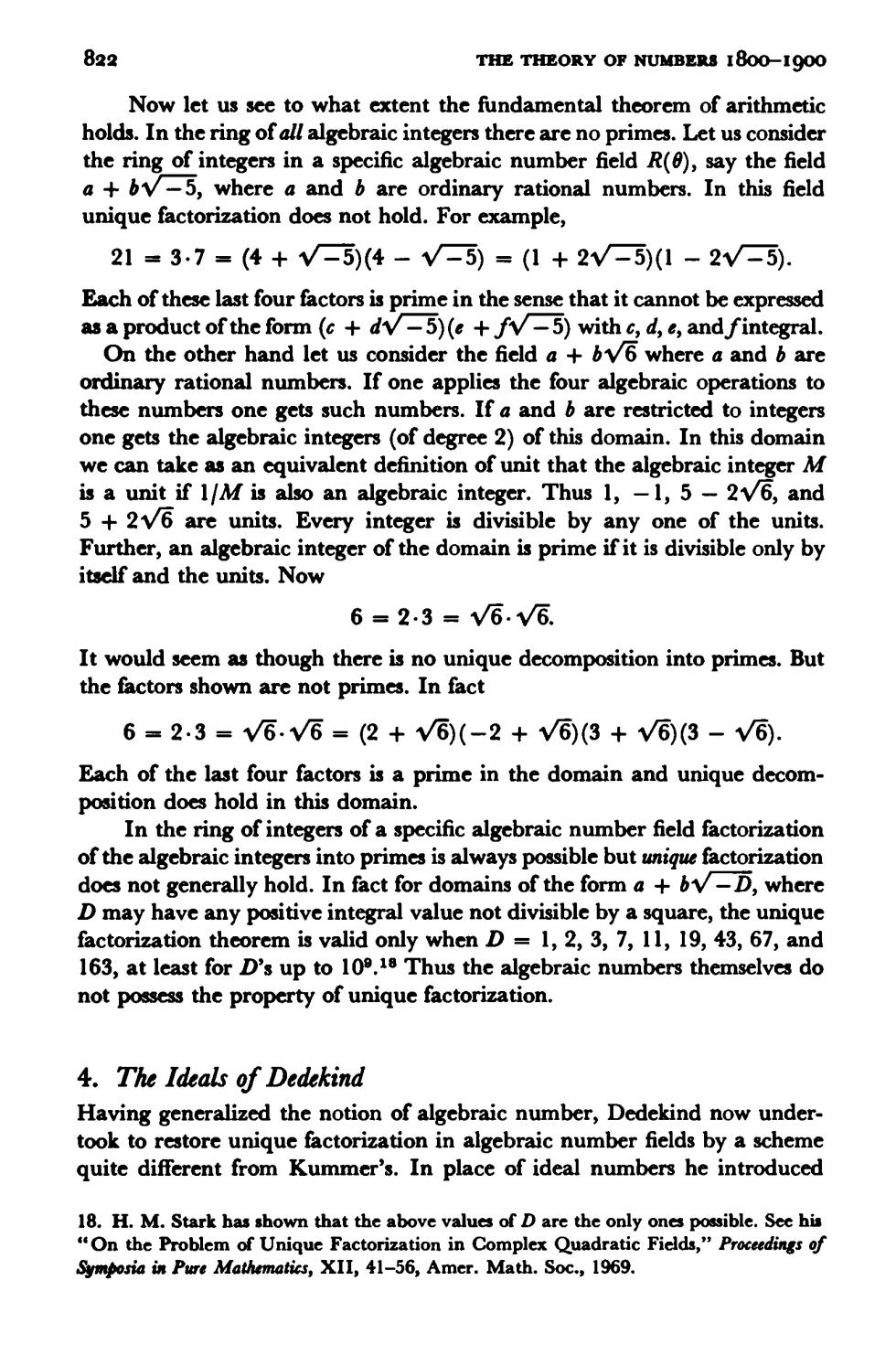
8r8 THE THEORY OF NUMBERS 1800-1900 The symbol (/B)has the following meaning:If p is any complex prime and k is any biquadratic residue not divisible by p,then(k)is the power ofiwhich satisfies the congruence KNP-)/4=1 modulo wherein No stands for the norm of.This law is equivalent to the statement: The biquadratic characters of two primary uneven prime numbers with respect to one another are identical,that is,(a/B)=(B/a)4,if either of the primes is congruent to 1 modulo 4;but if neither of the primes satisfies the congruence,then the two biquadratic characters are opposite,that is, (aB)4=-(/a) Gauss stated this reciprocity theorem but did not publish his proof This was given by Jacobi in his lectures at Konigsberg in 1836-37.Ferdinand Gotthold Eisenstein(1823-52),a pupil of Gauss,published five proofs of the law,of which the first two appeared in 1844. For cubic reciprocity Gauss found that he could obtain a law by using the"integers"a+bp where p is a root of x+1=0and a and b are ordinary (rational)integers but Gauss did not publish this result.It was found in his papers after his death.The law of cubic reciprocity was first stated by Jacobi and proved by him in his lectures at Konigsberg.The first published proof is due to Eisenstein.7 Upon noting this proof Jacobi claimed that it was precisely the one given in his lectures but Eisenstein indignantly denied any plagiarism.There are also reciprocity laws for congruences of degree greater than four 3.Algebraic Numbers The theory of complex integers is a step in the direction of a vast subject,the theory of algebraic numbers.Neither Euler nor Lagrange envisioned the rich possibilities which their work on complex integers opened up.Neither did Gauss. The theory grew out of the attempts to prove Fermat's assertion about x+y=z".The cases n 3,4,and 5 have already been discussed (Chap. 25,sec.4).Gauss tried to prove the assertion forn=7 but failed.Perhaps because he was disgusted with his failure,he said in a letter of 1816 to Heinrich W.M.Olbers (1758-1840),"I confess indeed that Fermat's theorem as an isolated proposition has little interest for me,since a multitude of such propositions,which one can neither prove nor refute,can easily be 5.Jow.fMah.,28,1844,53-67and22345. 6.Jow.fur Math.,2,1827,6669=Werk,6,233-37. 7.Jow.fMah,27,1844,289-310. 8.Jow.fur Math,30,1846,166-82,p.172=Wek,6,25474. 9.Jom.fMah,35,1847,135-274(p.273)

ALGEBRAIC NU几BERB 819 formulated."This particular case of n=7 was disposed of by Lame in 1839,10 and Dirichlet established the assertion for n=14.11 However,the general proposition was unproven. It was taken up by Ernst Eduard Kummer(1810-93),who turned from theology to mathematics,became a pupil of Gauss and Dirichlet,and later served as a professor at Breslau and Berlin.Though Kummer's major work was in the theory of numbers,he made beautiful discoveries in geometry which had their origin in optical problems;he also made important con- tributions to the study of refraction of light by the atmosphere. Kummer took x+y where is prime,and factored it into (x+)(x+g).(+a-y) where a is an imaginary pth root of unity.That is,a is a root of (1) a-1+a2-2+.+a+1=0, This led him to extend Gauss's theory of complex integers to algebraic numbers insofar as they are introduced by cquations such as(1),that is, numbers of the form f八a)=a0+41a+.+ap-2a-3 where each a is an ordinary (rational)integer.(Since a satisfies (1),terms in a-1 can be replaced by terms of lower power.)Kummer called the numbers f(a)complex integers. By 1843 Kummer made appropriate definitions of integer,prime integer,divisibility,and the like(we shall give the standard definitions in a moment)and then made the mistake of assuming that unique factorization holds in the class of algebraic numbers that he had introduced.He pointed out while transmitting his manuscript to Dirichlet in 1843 that this assump- tion was necessary to pr ove Fermat's theorem.Dirichlet informed him tha unique factorization holds only for certain primes A.Incidentally,Cauchy and Lame made the same mistake of assuming unique factorization for algebraic numbers.In 1844 Kummer1a recognized the correctness of Dirichlet's criticism. To restore unique factorization Kummer created a theory of ideal numbers in a series of papers starting in 1844.13 To understand his idea let us consider the domain of a +bv-5,where a and b are integers.In this domain 6=2.3=(1+V-5(1-V-5 10.Jow.de Math.,5,1840,195-211. 11.Jo.far Math.,9,1832,390-93=Wrk,1,18994 12.Jota.de Math.,12,1847,185-212. 13.Jow.far Math.,35,1847,319-26,327-67

820 THE THEORY OF NUMBERS 1800-1900 and all four factors can readily be shown to be prime integers.Then unique decomposition does not hold.Let us introduce,for this domain,the ideal numbers a =v2,B =(1+5)/V2,B2 =(1v5)/V2.We see that 6=a28182.Thus 6 is now uniquely expressed as the product of four factors,all ideal numbers as far as the domain a+b-5 is concerned.1 In terms of these ideals and other primes factorization in the domain is unique(apart from factors consisting of units).With ideal numbers one can prove some of the results of ordinary number theory in all domains that previously lacked unique factorization Kummer's ideal numbers,though ordinary numbers,do not belong to the class of algebraic numbers he had introduced.Moreover,the ideal numbers were not defined in any general way.As far as Fermat's theorem is concerned,with his ideal numbers Kummer did succeed in showing that it was correct for a number of prime numbers.In the first hundred integers only 37,59,and 67 were not covered by Kummer's demonstration.Then Kummer in a paper of 185715 extended his results to these exceptional primes.These results were further extended by Dimitry Mirimanoff(1861 1945),a professor at the University of Geneva,by perfecting Kummer's method.Mirimanoff proved that Fermat's theorem is correct for eachn up to256 if,and z are prime to that exponentn. Whereas Kummer worked with algebraic numbers formed out of the roots of unity, ,Richard Dedekind (1831-1916),a pupil of Gauss,who spent fifty years of his life as a teacher at a technical high school in Germany, approached the problem of unique factorization in an entirely new and fresh manner.Dedekind published his results in supplement 10 to the second edition of Dirichlet's Zahlentheorie (1871)which Dedekind edited.He extended these results in the supplements to the third and fourth editions of the same book.1'Therein he created the modern theory of algebraic numbers Dedekind's theory of algebraic numbers is a generalization of Gauss's complex integers and Kummer's algebraic numbers but the generalization is somewhat at variance with Gauss's complex integers.A number r that is a root of 3 aox"+a1x4-1+.+a-1x+an=0, where the ar's are ordinary integers (positive or negative),and that is not a root of such an equation of degree less than n is called an algebraic number of degree n.If the coefficient of the highest power of in(2)is 1,the solutions are called algebraic integers of degree n.The sum,difference,and product of 14.With the introduction of the ideal numbers,2 and 3 are no longer indecomposable, for 2 a3 and 3 B1B2. 15.Abh.Konig.Akad.der Wiss.Berlin,1858,41-74. 16.Jouw.far Math.,128,1905,4568. 17.4thcd,1894=Wrke,3,2-222

ALgeBralc numBers 821 algebraic integers are algebraic integers,and if an algebraic integer is a rational number it is an ordinary integer We should note that under the new definitions an algebraic integer can contain ordinary fractions.Thus(-13 +V-115)/2 is an algebraic integer of the second degree because it is a root of x2+13x+71 =0.On the other hand (1-V-5)/2 is an algebraic number of degree 2 but not an algebraic integer because it is a root of 2x2-2x +3=0. Dedekind introduced next the concept of a number field.This is a collection F ofreal or complex numbers such that if and B belong to F then so do a+B,a-B,aB and,if B0,a/B.Every number field contains the rational numbers because if a belongs then so does a/a or I and consequently 1+1,1+2,and so forth.It is not difficult to show that the set of all algebraic numbers forms a field. If one starts with the rational number field and is an algebraic number of degree n then the set formed by combining with itself and the rational numbers under the four operations is also a field of degree n.This field may be described alternatively as the smallest field containing the rational numbers and a.it is also called an extension field of the rational numbers.such a field does not consist of all algebraic numbers and is a specific algebraic number field.The notation R()is now common.Though one might expect that the members of R(0)are the quotients f(0)/g(0)where f()and g(x)are any polynomials with rational coefficients,one can prove that if is of degree n, then any member a of R()can be expressed in the form a=ao0m-1+10m-2+·+an-1 where the a are ordinary rational numbers.Moreover,there exist algebraic integers ,2,.,0 of this field such that all the algebraic integers of the field are of the form A101+A202+.+An0, where the A are ordinary positive and negative integers A ring,a concept introduced by Dedekind,is essentially any collection of numbers such that if a and 8 belong,so do a+B,a-B,and aB.The set of all algebraic integers forms a ring as does the set of all algebraic integers of any specific algebraic number field. The algebraic integer a is said to be divisible by the algebraic integer B if there is an algebraic integer y such that a=By.Ifj is an algebraic integer which divides every other integer of a field of algebraic numbers then j is called a unit in that field.These units,which include +1 and-1,are a generalization of the units +1 and-I of ordinary number theory.The algebraic integer is a prime if it is not zero or a unit and if any factorization of a into By,where B and y belong to the same algebraic number field, implies that 8 or y is a unit in that field

822 THE THEORY OF NUMBERS 1800-1900 Now let us see to what extent the fundamental theorem of arithmetic holds.In the ring of alalgebraic integers thereareno primes.Let us consider the ring of integers in a specific algebraic number field R(),say the field a+bv-5,where a and b are ordinary rational numbers.In this field unique factorization docs not hold.For example, 21=3.7=(4+V-5(4-V-5=(1+2V-5(1-2W-5: Each of these last four factors is prime in the sense that it cannot be expressed as a product of the form (c +dv-5)(e +fv-5)with c,d,c,and fintegral. On the other hand let us consider the field a+bv6 where a and b are ordinary rational numbers.If one applies the four algebraic operations to these numbers one gets such numbers.If a and b are restricted to integers one gets the algebraic integers (of degree 2)of this domain.In this domain we can takeas an cquivalent definition of unit that the algebraic integerM is a unit if 1/M is also an algebraic integer.Thus 1,-1,5-2v6,and 5+2V6 are units.Every integer is divisible by any one of the units. Further,an algebraic integer of the domain is prime if it is divisible only by itself and the units.now 6=2.3=√6.V6 It would seem as though there is no unique decomposition into primcs.But the factors shown are not primes.In fact 6=2.3=√6.√6=(2+√⑥(-2+V⑥)(3+V⑥(3-V6). Each of the last four factors is a prime in the domain and unique decom position docs hold in this domain. In the ring of integers of a specific algebraic number field factorization of the algebraic integers into primes is always possible but unigue factorization does not generally hold.In fact for domains of the form a +bv-D,where D may have any positive integral value not divisible by a square,the unique factorization theorem is valid only when D =1,2,3,7,11,19,43,67,and 163,at least for D's up to 10Thus the algebraic numbers themselves do not possess the property of unique factorization 4.The Ideals of Dedekind Having generalized the notion of algebraic number,Dedekind now under- took to restore unique factorization in algebraic number fields by a scheme quite different from Kummer's.In place of ideal numbers he introduced 18.H.M.Stark has shown that the above values of D are the only ones ible See hi